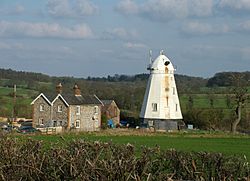Lower Mill, Dalham facts for kids
Quick facts for kids Dalham Mill |
|
|---|---|

Lower Mill, August 2005
|
|
| Origin | |
| Mill name | Lower Mill, Opposition Mill |
| Mill location | TL 719 617 |
| Coordinates | 52°13′36″N 0°31′04″E / 52.22667°N 0.51778°E |
| Operator(s) | Private |
| Information | |
| Purpose | Corn mill |
| Type | Smock mill |
| Storeys | Three-storey smock |
| Base storeys | One storey |
| Smock sides | Eight sides |
| No. of sails | Four Sails |
| Type of sails | Patent sails |
| Windshaft | Cast iron |
| Winding | Fantail |
| No. of pairs of millstones | Three pairs |
Lower Mill, also known as Opposition Mill, is a special type of windmill called a smock mill. You can find it in Dalham, Suffolk, England. It's so important that it's a Grade II* listed building. This means it's protected because of its history and unique design. This old mill has been carefully saved and looked after!
Contents
History of Dalham Mill
Building and Early Years
Lower Mill was built in the 1790s. A person named Mr. Ruffle was responsible for its construction. Not long after it was built, in 1802, the mill faced a challenge. Its large sails were blown off by strong winds.
Working Life and Decline
The mill continued to operate for many years. It was actively working until 1926. By 1935, the mill was getting old and needed a lot of repairs. These repairs were finished in 1938. However, after these fixes, the mill started to fall apart again.
Restoration Efforts
In 1972, a person named Frank Farrow bought the mill. He wanted to bring it back to life and make it work again. Restoration work began with help from grants. These grants came from Suffolk County Council and the Historic Buildings Council for England. The main restoration work was done by engineers from 1979 to 1980.
How Dalham Mill Works
Mill Structure and Design
Lower Mill is a smock mill. This means it has a wooden tower that looks a bit like a person wearing a smock (a loose shirt). The tower has three floors. It sits on a strong base made of brick, which has one floor.
Cap and Sails
The top part of the mill is called a beehive cap. It has a walkway around it, called a gallery. This cap could turn to face the wind. It used a special part called a fantail to do this automatically. The mill had four large sails. These were "Patent sails," which could adjust themselves to the wind. Each sail was about 27 feet (8.2 meters) long and 7 feet (2.1 meters) wide.
Inside the Mill
The sails were connected to a strong cast-iron shaft. This shaft helped to power the mill's machinery. Inside, the mill had three pairs of millstones. These stones were used to grind corn into flour. They were located on the first floor of the mill.
Millers of Dalham Mill
- William Ruffle (1804-1855)
- George Moore (1855-1875)
- Abraham Simpson (1875-1885)
- Joseph Tabraham (1875-?)
- John Tabraham (1875-?)
- Josiah Tabraham
- John Tabraham
- Lewis Tabraham
- Elijah Rutterford (1904)
- Charles Kerridge (1908)
- Turner (until 1926)

